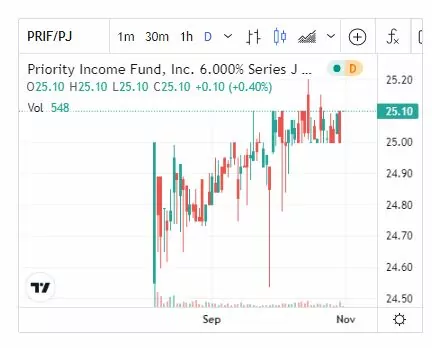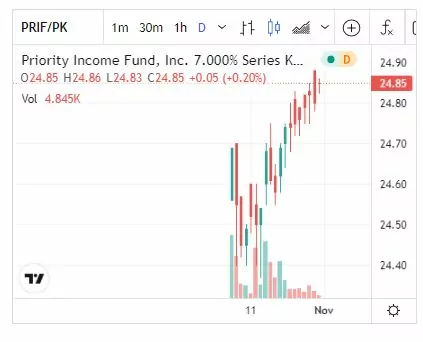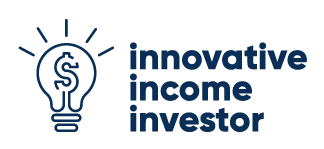It is time to do a case study on some preferred stocks.
It is not often that we have an issuer sell not only ‘term preferreds’ but ‘perpetual preferreds’ as well. This situation lends itself to a study of how the price of a ‘perpetual’ acts versus pricing on a ‘term’ preferred when interest rates rise or fall. Necessarily this ‘study’ may last a few years–depends on how fast we see rising or falling interest rates.
This study will be of the new issue Priority Income Fund 7.00% perpetual preferred (PRIF-K) VERSUS the relatively new Priority Income Fund 6.00% term preferred (PRIF-J).
The study will hone in on the ‘total return‘ of each of the securities. I will look at this TR every few months and update the findings.
The J issue was issued on 8/6. Currently trading around $25.10 with a 6.00% coupon.

The K issue which is perpetual and is now trading at $24.85 with a 7.00% coupon.

We all know that, as a general rule, a security price moves lower when interest rates rise–while the security price rises when interest rates fall.
Short dated maturity securities tend to move less violently relative to a perpetual preferred as interest rates rise. The 6.00% J issue has a redemption date in 2028. Of course the 7.00% J issue has NO mandatory redemption date.
Now if you as an investor have no concern whatsoever on price movement – you only care about an income stream–immediate income–this study means nothing to you. Likely you want the 7% issue which will pay you an additional 25 cents/share annually.
If you believe that interest rates are moving sharply higher and are sensitive to capital preservation maybe it is better to own the term preferred at a modestly lower income stream in return for less price movement.
Each investor has their own goals–their income needs. There is no right or wrong answer in what one buys (relative to the above situation)–only the best answer for yourself.

Received a letter today from Priority Income Fund via snail mail.
They say they tried to contact me unsuccessfully regarding an important matter about the operating initiative of the Fund.
They say it’s very important they talk to me about this, and to call an 800 number during 9:00 am – 10:00 PM EST.
Have any of you received a similar letter?
What’s this all about?
I received the same thing. I was waiting to see if anybody here on III had received it. I looked on their web site but saw nothing. Makes me suspicious. I’m guessing it’s a sales pitch.
Have not received a letter from Priority but I have received a multitude of phone calls from a number that traces to them but also shows up as a robocall, so I have not been answering… Given I’m not even a shareholder and only owned preferreds on and off for quick flips, this seemed excessive..
I’m reluctant to call the number they provided, as that may put me on their robocall list.
It seems awfully suspicious to me, as JDC says. Why would they not tell me what the “important” information is? Plus they have not contacted me before as they claim to have done.
I Googled the 800 number in their letter and its listed as a RoboCall. So it does seem that this is some kind of spamming or phishing effort.
I get that letter as a psec shareholder-it’s a call to proxy vote. I don’t know why preferred shares would get it if they don’t vote.
Yeah, my only investment is in their Preferred Shares, so I have no voting privileges.
Anyway, I intend to ignore it.
Some newer viewers might not understand how preferreds with different coupon yields will perform if interest rates rise. Here is a brief theoretical study illustrating how four different preferreds that IPO’ed in 2021 will perform if the US Treasury 10 year (UST10) rises. The UST10 closed at 1.557% today (10/29/21). The study predicts prices if the UST10 rises by 1.0%, 2.0% and 3.0%. With a rise of 3.0%, the UST10 would be at 4.557% which is still less than the 5.0% considered normal in times past. I have chosen four issues with coupon yields of 4.0%, 5.0%, 6.0% and 7.0% and like I mentioned, all of them IPO’ed this year. The percent price change is shown for each of the +1%, +2%, +3%
Unfortunately, the data I try to present somehow blows up the website posting gods. It says I am attempting a “potentially unsafe operation.” My apologies.
Is there no way to share the results? I find your post interesting. Perhaps the results can be simplified to pass the filter gods?
I look at the term as a 6% seven year CD but with a very slight risk if I have done my homework before buying. If I buy at $25 and act like it is a sock drawer candidate I know that I will get 6% for the next seven years and get my $25 back at the end. The price may fluctuate but in the end I will get my $25 back. IF (note the capital IF)the issuer looks like it is getting into trouble and it looks like they may not be able to fulfill their commitment I can sell at a loss. But, I received a good return while it lasted and hopefully get out without getting badly burned. No preferred or baby bond in my portfolio is more than 3-4% of my current holdings so a complete loss on one would not be tragedy. When I get within a year of maturity I watch the price and sell and take my profit if its current price is considerably over $25. If the price is still hovering around $25 I hold until maturity.
RaDABoz–agree with you completely. I personally believe rates are moving higher so it is the place to be–on the other hand I have thought they were going higher for a long time.
Tim for younger investors who don’t remember what the 70’s , 80’s and even early 90’s were like with inflation and high interest rates I’ve copied a chart showing in CANADA the average 5 yr Fixed Rate Mortgage vs Variable Mortgage (which would be appx the Prime rate). I expect the US would be very similar. As we know bond values can get extremely nasty in a rising rate environment thus the need for some prudence.
Year Variable Rate 5 Year Rate Best Rate? Best Over Worst
1975 8.70% 11.50% variable 2.80%
1976 9.95% 12.00% variable 2.05%
1977 7.95% 10.25% variable 2.30%
1978 8.95% 10.25% variable 1.30%
1979 11.70% 11.25% fixed 0.45%
1980 13.45% 14.50% variable 1.05%
1981 19.20% 18.13% fixed 1.07%
1982 16.20% 19.25% variable 3.05%
1983 10.70% 13.50% variable 2.80%
1984 11.70% 13.50% variable 1.80%
1985 10.20% 11.75% variable 1.55%
1986 9.95% 11.25% variable 1.30%
1987 9.20% 11.25% variable 2.05%
1988 10.45% 11.75% variable 1.30%
1989 13.20% 12.00% fixed 1.20%
1990 13.95% 13.25% fixed 0.70%
1991 9.45% 11.25% variable 1.80%
1992 7.20% 9.63% variable 2.43%
1993 5.70% 8.85% variable 3.15%
1994 6.70% 9.90% variable 3.20%
1995 7.95% 8.95% variable 1.00%
1996 6.20% 7.95% variable 1.75%
1997 4.45% 7.00% variable 2.55%
1998 6.20% 6.95% variable 0.75%
1999 5.95% 7.50% variable 1.55%
2000 7.20% 8.30% variable 1.10%
2001 5.95% 7.50% variable 1.55%
2002 3.95% 6.85% variable 2.90%
2003 4.45% 6.45% variable 2.00%
2004 3.70% 6.30% variable 2.60%
2005 3.95% 6.05% variable 2.10%
2006 5.70% 6.60% variable 0.90%
2007 5.70% 7.19% variable 1.49%
2008 4.45% 7.15% variable 2.70%
2009 1.95% 5.79% variable 3.84%
2010 2.20% 5.42% variable 3.22%
2011 2.70% 5.39% variable 2.69%
2012 2.70% 5.24% variable 2.54%
2013 2.70% 5.24% variable 2.54%
2014 2.70% 4.79% variable 2.09%
2015 2.55% 4.64% variable 2.09%
2016 2.40% 4.64% variable 2.24%
2017 2.40% 4.64% variable 2.24%
2018 3.15% 5.34% variable 2.19%
2019 3.65% 5.34% variable 1.69%
2020 2.15% 4.94% variable 2.79%
2021 2.15% 4.79% variable 2.64%
Posted Mortgage Rates for 1, 3, and 5
The trouble Buck, is for us “of a certain age” we just remember back to then…
History shows the answer can be conflicting not inevitable (at least for a decade or more). I am just old enough pushing 60 to see basically 10 yr a few hundred bps or so typically above inflation. But the 1940s proved that inflation can run a lot hotter than 10 year than even today. Look at this chart.
https://www.cpsimis.com/pdfs/History%20of%20Long-Term%20Interest%20Rates%20BW.pdf
Of course I agree the pocket book risk is to the upside, so mitigate the best I can, while avoiding things I cant trust or unwilling to understand. But when its said and done I still own them all. From lower 4% high quality illiquids, to pinned to par higher yielders, to adjustables, and term dated also.
As crazy as it sounds the 40 year trek of descending long end yield remains unbroken.
Grid–exactly why I hedge my bets–I saw rate are heading higher, but won’t bet me first born on it. Stuff happens–now we shift from worrying about inflation to worrying about a recession. The taper is to begin, but will it last and if it does what are the odds the Fed raises rates afterward? What are the odds of a recession and the Fed pivoting to move in a dovish direction to try to repeal the business cycle as they have done for years.
Tim, remember way back in “WIN” button era and 80s when the political cry was budget deficits cause high interest rates? That battle cry seems so long ago now doesnt it. But nothing lasts forever. Except possibly Tom Brady always winning, lol.
Looking at the interest rate vs inflation chart, there is an interesting downward trend for 50 years – right around coming off the gold standard.
I listened to a Raymond-James CIO podcast, and he claimed a direct correlation to higher deficits leading to lower interest rates (for developed countries). “The US gov’t is paying less in interest payments now than the 1940s.” The declining chart matches from the mid-1980s when US deficits really started to climb, and interest payments were a higher % than now (JP is more dramatic). Stand on your head stuff. Causation?
I’d take a solid 6-7% for ten years with this correlation.
I believe “WIN” = Whip Inflation Now. Please correct if I am wrong. Thanks.
Yes, thats correct.
Nothing lasts forever. That’s what I said in 2013 when the 11.5% 30 year treasuries I bought in 1983 matured. Hands-down my single best (risk adjusted) investment.
Tim – I think there is zero % chance of a recession right now. Powell or whoever takes his spot will be dovish and keep rates low so govt. can fund itself. The time to get nervous is when they invert the yield curve and we are years from that happening.
“ The time to get nervous is when they invert the yield curve and we are years from that happening.”
20-30 just inverted. 20 year rate is above the 30 year rate.
LI – 3mo./ 10y
3mo/10y is typically the last part of the curve to invert. In some recessions it never inverted.
That is true, but stock market tops have come after that part of the curve inverts. Also, a good time to buy bonds as a recession usually follows months after inversion. ATB
Canuck–remember this well as I took out a mortgage in 1980.
Likewise Tim – I finished university and started my banking career in spring 1980. Canada Savings Bonds that year were 11.5% next year in 1981 CSB’s were 19.5% (which my parents loved) while my car loan (at staff rate) was 22%. Luckily Paul Volker’s medicine started taking hold after that peak.
High interest rates paid for a free year of my college in the 1980s. My Dad paid first two and I was on the hook for other two. So I max loaded up on student loans for 3 years and got between 12%-16% on my student loan CDs for 3 years. The interest that was collected from the CDs paid my senior year, so I got out pretty cheap. In fact after graduating CDs were still higher than my loan rate so I milked the spread a few more years before paying it off.
My dad thought I was crazy to buy a house in 83 and pay 12% couple years later I refinanced for 8% Then sold that one and bought another one in 1992 with a variable. Kept the same loan and it will be paid off in 6 months.
Now today,
The salesman told me not to expect my new truck until the 1st week or second week of Nov.
I know the 0% interest Ford is offering ends Nov. 1st.
But finding out it was in the railyard 60 miles away last Sat. I kept driving by the dealership every day this week. Last night, we spotted a shiny red truck in the lot. Knocked on the door at 5:30 and salesman was still there.
Asked him about the truck, said it couldn’t be mine then he went and looked and pulled the paperwork and it is. Told him I want to come down today to finalize paperwork and apply for that 0% loan told me the owner would have to enter into the system. Didn’t seem happy.
As a investor, I want the highest return with the least risk on my investments. I want the opposite when I borrow !
I really wish I could think more like you, but I just don’t have the courage.
I have been far too conservative and risk averse almost my entire investing career. So, I am usually wrong. Fortunately, my misplaced bearishness has been offset by my unwillingness to sell and take capital gains on some remarkable common stocks, and, also counterbalanced by my IPO flipping.
I cannot invest like you because I’m getting too old to emotionally handle the inevitable temporary drawdowns associated with owning too many securities during panicky conditions. Even if one is well diversified, securities prices become very highly correlated during mass fear. Given current conditions, I can only be comfortable with at least 50% of my assets in some combination of cash equivalents, CDs, and A++ rated insurance products. For me, income is just not adequate compensation for the stress caused by significant paper losses.
af—I’m pretty old myself and sympathize with your cautiousness. I was around when 3-month bills were trading at 21% and the 30-year T-bond was at 15% in the late 70’s. I keep about 15-20% in cash or short term maturities. You are more cautious than I am.
More than that, I keep a diversified portfolio and don’t load up on any one security unless I feel very comfortable with it. I own a ton of BB+ bank preferreds that I bought back in 2014-2016. They’re callable in 2024 and way and way up in price, but I’ll just hold them for a couple of years. I also own a ton of RLJ-A busted convertible and the WFC-L busted convertible.
Other than that, I basically own a full position in many, many different issues. My two biggest losers are the Teekay (now Altera Infrastructure) issue that is now owned by Brookfield with a suspended dividend and the ONTRAK-A issue that is falling like a heavy stone. Definitely not two of my better investment decisions. My goal is to maintain my very comfortable retired lifestyle, but be careful that I’m not eating dogfood when I hit 90.